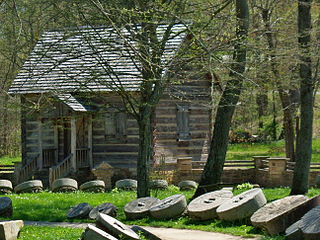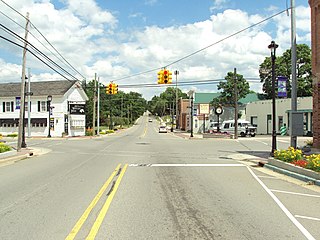
Richmond is a city within Metro Detroit in the U.S. state of Michigan. The population was 5,735 at the 2010 census. Most of the city is located in Macomb County, though there is a small portion in neighboring St. Clair County. The city is adjacent to Richmond Township and Lenox Township in Macomb County, although it is administratively autonomous. It is also adjacent to St. Clair County's Columbus Township and Casco Township.

Northville is a city in Oakland and Wayne counties in the U.S. state of Michigan. The population was 5,970 at the 2010 census.
Pioneer Village is located inside of the Lagoon Amusement Park in Farmington, Utah. Meant to be a “living museum", Pioneer Village includes artifacts and mementos housed in over two dozen structures, intended to make the history of Utah come alive. It was founded in 1938 near Salt Lake City by Horace and Ethel Sorensen. In April 1975, Lagoon bought the collection from the Sons of Utah Pioneers, and it opened at the amusement park in 1976.

Genesee Depot is a small unincorporated community in Waukesha County, Wisconsin, United States. It is in the Town of Genesee, in southeastern Wisconsin between Milwaukee and Madison, and named for the train station, or depot, of the Wisconsin and Calumet Railroad that formerly served the town. Wisconsin State Highways 59 and 83 intersect in Genesee Depot.

Disco, Michigan was a village in what is now Shelby Charter Township, Michigan.

White Pine Village is an outdoor museum in Ludington, Michigan, containing nineteenth-century buildings and related historical items. The thirty buildings in the village contain artifacts relating to pioneer lumbering, music, farming, shipping, sports, and businesses. Occasionally performances are done on blacksmithing, spinning, leatherworking, candlemaking, wood carving, and basket making. The museum's centerpiece is an 1849 farmhouse.

Levi Jackson Wilderness Road Park is a former state park located just south of London, Kentucky in Laurel County. It is now a city park under the auspices of the city of London, KY. The park encompasses 896 acres (363 ha) and includes a section of the Wilderness Road that early settlers used to reach Kentucky. The park is named for Levi Jackson, an early Kentucky pioneer. It serves as both a recreational and historic park.

Nixon Township is one of thirteen townships in DeWitt County, Illinois, USA. As of the 2010 census, its population was 571 and it contained 250 housing units.

Lang Pioneer Village Museum is a living history museum located in the hamlet of Lang in Peterborough County, Ontario. It was established in 1967 by the County of Peterborough. Lang Pioneer Village is situated on the shores of the historic Indian River. Lang Pioneer Village is an "outdoor museum" featuring more than 30 restored and furnished buildings, many of which were donated from the surrounding townships. The buildings, constructed between 1820 and 1910, are interpreted by costumed villagers portraying authentic 19th-century pioneer life. Since 2014 the Museum has been the site of the Aabnaabin Encampment, a pre-colonization representation of a Michi Saagiig camp where the story of the First Nations history and culture of the region is told by indigenous interpreters. Lang Pioneer Village Museum is owned and operated by the County of Peterborough.

Historic Charlton Park is a historically oriented local facility and museum in Barry County, Michigan, that sits on 310 acres (1.3 km2) along the Thornapple River.
The South Peace Centennial Museum is an open-air museum in central Alberta, Canada. The museum's buildings include homesteaders' cabins, a trading post, church, school, grist mill, community hall, general store, blacksmith shop, barn, carriage house, and railway buildings. The museum also features an extensive collection of antique tractors, steam engine, stationary engines, horse-drawn wagons, carriages and antique automobiles.

Pickwick is an unincorporated community in Homer Township, Winona County, Minnesota, United States.

The Metamora Crossroads Historic District is a historic district centered at the intersection of Oak and High Street in the small village of Metamora in Metamora Township in Lapeer County, Michigan. It was designated as a Michigan State Historic Site and also added to the National Register of Historic Places on July 19, 1984.

The West Saint Clair Street Historic District is a residential historic district located along 124–328 West Saint Clair Street in the village of Almont in Almont Township in southeast Lapeer County, Michigan. It was designated as a Michigan State Historic Site and also added to the National Register of Historic Places on May 8, 1986.

Fanshawe Pioneer Village is an open-air museum established in 1959 and located in the Fanshawe Conservation Area in London, Ontario. The village uses historical re-enactments to communicate the history of rural communities in the former townships of Westminster, London, North Dorchester, Delaware, West Nissouri and Lobo in Middlesex County from 1820 to 1920 and the founding and development of the City of London up to 1840.

The Iron County MRA is a Multiple Resource Area addition to the National Register of Historic Places, which includes 72 separate structures and historic districts within Iron County, Michigan, United States of America. These properties were identified and placed on the Register in 1983, with the exception of one property that was placed on the Register in 1993.

The Pioneer Living History Museum is located at 3901 W. Pioneer Road in Phoenix, Arizona. The museum, also known as Pioneer Village, has 30 historic original and reconstructed buildings from the 1880s and early 1900s on its 90-acre property.

The Huron City Historic District is a historic district encompassing the village of Huron City, Michigan, with structures located primarily along Pioneer Drive. The district was listed on the National Register of Historic Places in 1995.

















